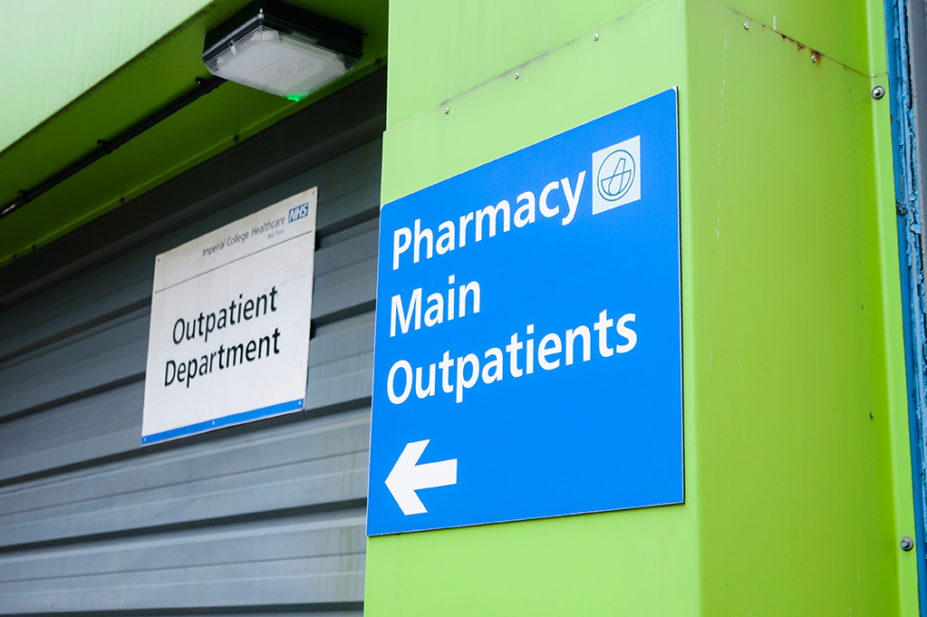
Stephen Barnes/Medical / Alamy Stock Photo
Some hospital pharmacy teams in England are facing absence rates of up to 30% and there is a danger that some services may have to be withdrawn if absence rates go any higher, chief pharmacists have told The Pharmaceutical Journal.
The warning comes after the UK reported a record number of 218,724 COVID-19 cases on 4 January 2021 — of which 148,725 were recorded in England.
The latest surge in COVID-19 cases, which have been steadily climbing since the Omicron variant was first detected in November 2021, has caused multiple hospital trusts to declare a ‘critical incident’, which NHS England says occurs “where the level of disruption results in the organisation temporarily or permanently losing its ability to deliver critical services”.
Raliat Onatade, group chief pharmacist and clinical director for medicines optimisation at Barts Health NHS Trust, said the pharmacy team at her trust was “experiencing significant absences due to a combination of people testing COVID-positive and others isolating because they are contacts”.
“This has been the case over the Christmas and New Year period and is still continuing. I don’t have all the numbers, but I estimate [the absence rate to be] between 20% to 30%,” she said.
As a result of the high absence rate, Onatade said the trust had “outsourced some of our aseptics production”, adding that the team was “also stretched thin on some ward areas and are prioritising high-risk units and discharges, minimising deskwork and cancelling non-priority meetings”.
James Harris, chief pharmacist at University Hospital of North Durham, said his team also had “significant numbers of staff affected — about 10%”.
“This is a mixture of staff that have tested positive, but also those identified as COVID-19 contacts.
“NHS staff are required to have a negative PCR [test] before returning to work, and both pillar 2 public testing and our own in-hospital testing have capacity issues,” Harris explained. “We are managing to get our staff prioritised for in-house testing currently.”
Under the government’s national testing strategy, ‘pillar 2’ includes PCR testing for the wider population.
Harris added that to cope with the staff absences, the pharmacy team had “redeployed pharmacy management staff to support operational and clinical functions — to cover ITU for example — and release staff from dispensary duties to provide clinical cover to wards”.
“We haven’t had to withdraw any services yet but will have to consider it if further staff test positive,” he continued.
Ruth Ayre, deputy chief pharmacist at the central and south localities of Cumbria, Northumberland, Tyne and Wear NHS Foundation Trust, said her team was “currently managing a 15% absence of staff within the pharmacy department, of which 80% are COVID-19 related”.
She said the pharmacy team was able to maintain pharmacy services using Microsoft Teams, electronic prescribing and medicines administration systems and electronic patient records, as well as “cross-site cover and prioritisation of the clinical pharmacy service to support in-patient services over mental health community teams (though providing remote enquiry answering and some essential onsite clinical activities)”.
“We have increased our involvement within in-patient areas, where possible, to aid nursing and medical colleagues with more medicine-related tasks,” Ayre said. “This is regularly reviewed to ensure our own medicine supply service is not affected.”
Roger Fernandes, director of pharmacy at King’s College Hospital NHS Foundation Trust, said that his trust also had “staff absences on all our sites but no different to other departments in the hospital and certainly no different to other hospitals in London”, adding that a good vaccine uptake “has helped”.
In December 2021, NHS England declared a level 4 national incident “in recognition of the impact on the NHS of both supporting the vital increase in the vaccination programme and preparing for a potentially significant increase in COVID-19 cases”.
This led to the introduction of a range of measures designed to free up capacity within NHS trusts, including the temporary suspension of Care Quality Commission inspections.
How the surge in COVID-19 cases is affecting community pharmacy
Community pharmacy has long faced workforce issues, with high-level talks currently underway between pharmacy representatives and government officials to discuss the limited availability of pharmacists for community pharmacy roles.
However, Leyla Hannbeck, chief executive of the Association of Independent Multiple Pharmacies, said pharmacy staff undertaking COVID-19-related isolation “are adding to this already big workforce challenge and we have reports from across the independents and multiples about branch closures because of this”.
A spokesperson for the National Pharmacy Association added that it was “concerned that many pharmacies could face staff shortages over the coming weeks, and we are monitoring the situation”.
Under national guidance, community pharmacies are able to give NHS England 24 hours’ notice of temporary changes to opening hours or temporary closures “in exceptional circumstances where a contractor is unable to engage a (locum) pharmacist and thus unable to open the pharmacy for its contractual hours, despite best endeavours to do so”.
Gordon Hockey, director of legal at the Pharmaceutical Services Negotiating Committee, said: “The recent increase in cases amongst the wider population will be mirrored in pharmacies, with some areas reporting that they are feeling the pressure more acutely.
“We know that contractors are working tirelessly to keep their doors open through this latest wave, but the NHS needs to take a pragmatic and flexible approach to support pharmacies over the winter.”
Read more: There is an official shortage of pharmacists: what now?


